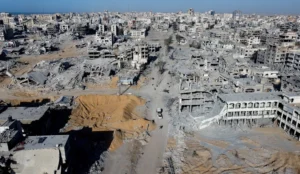With one eye on reconstruction, the US won’t let fragile Gaza ceasefire go up in smoke

A drone view shows the destruction in a residential neighborhood of Gaza City after the withdrawal of the Israeli forces from the area, amid a ceasefire between Israel and Hamas in Gaza, 21 October 2025
Liza Rozovsky writes in Haaretz on 22 October 2025:
Last week, a new building in southern Israel’s Kiryat Gat industrial zone officially turned into the Civilian Military Cooperation Center. Established by the United States with support from other countries, the center is intended to help preserve the fragile cease-fire in the Gaza Strip, oversee its implementation, prevent friction among various forces expected to operate in Gaza, and ensure sufficient humanitarian aid is delivered.
On Tuesday, U.S. Vice President JD Vance held a press conference there together with President Donald Trump’s special envoy, Steve Witkoff; Trump’s adviser and son-in-law, Jared Kushner; and the head of CENTCOM, Adm. Brad Cooper. The event effectively served as the center’s inauguration. According to one speaker, Vance spent the entire afternoon in hours-long briefings with American and Israeli military personnel.
German, British, Canadian, Danish and Jordanian flags were placed around the small podium from which Vance spoke in the giant hangar, whose floor was covered with synthetic grass. American and Israeli flags were placed behind the podium, in the center of the room – but no Israeli official was present.
Israeli officers and American soldiers roamed the building, along with some British soldiers wandering as well. One floor of the building, according to a new paper sign hung on one of the doors, was exclusively for the Americans; another was reserved for Israelis only. The press conference was held on the floor shared by both countries and both armies.
Senior U.S. officials noted the flags don’t encompass all the countries contributing to the initiative. But from the speech itself, it was clear that almost nothing is clear except for one simple fact: The Americans see the fragile cease-fire they brokered as a great achievement and don’t intend to let it disappear. The 20 points in Trump’s plan, which were printed on two signboards behind the speakers as if they were the tablets of the Ten Commandments, reinforced the message.
Like Trump, Vance also declined to set a deadline for disarming Hamas. He even stressed that both Israel and the Gulf States (by which he apparently meant Saudi Arabia and the United Arab Emirates) would need to be patient on this issue.
So far, not a single country has said they will formally be participating in the international stabilization force. Granted, Trump on Tuesday lavished praise on Indonesia, the only country that has said it is willing to contribute 20,000 troops. But Washington has run into problems recruiting other countries, as the New York Times, among others, reported on Tuesday. And the one country that has said it would be happy to send troops terrifies Israel.
When asked about the possibility of Turkey contributing troops, Vance said there will be no “troops are on the ground in Israel” without Israel’s consent (it’s not clear whether he simply forgot that Gaza isn’t part of Israel, whether this was a Freudian slip or whether it was semi-intentional, with the goal of creating ambiguity). But he stressed that Turkey has a constructive role to play in Gaza, even if not necessarily a military one. Vance was especially emphatic on one point: no American troops will enter Gaza. There may be other countries that would like to openly say the same, but haven’t due to fear of massive American pressure.
Perhaps the most astonishing part of the U.S. plan – glimpsed between vague but optimistic statements – is the intent to start reconstructing parts of Gaza that are still under full Israeli control. Senior American officials hinted at this last week, and Kushner said it in front of the cameras on Tuesday.
When asked whether Washington is in fact considering initiating reconstruction in areas controlled by Israel, Vance passed the baton to Kushner, who said it definitely was. “There are considerations … happening now in the area that the IDF controls, as long as that could be secured, to start the construction [of] a new Gaza in order to give the Palestinians living in Gaza a place to go, a place to get jobs, a place to live,” he said.
What this may mean in practice is that the idea of a “humanitarian city” in Israeli-controlled areas, which was discussed by the cabinet a few months ago and which Netanyahu ordered the army to start preparing for, hasn’t been completely abandoned.
Last week, a senior Trump administration official spoke of the possibility of creating a “nice way for people to live” in areas like Rafah, which are free of Hamas and under Israeli control. In this context, it’s worth noting that the Gaza Humanitarian Foundation, which has currently halted its activities in Gaza, says it plans to resume them soon depending on conditions on the ground.
But perhaps most importantly, if Gaza’s reconstruction indeed starts under full Israeli control, and if Gazans therefore somehow begin moving to the areas Israel controls, this could entrench the current situation on the ground and prevent Israel from withdrawing from more than half of Gaza for many years to come.
This article is reproduced in its entirety
